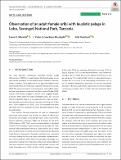| dc.description.abstract | The oribi (Bovidae: Antilopinae: Ourebiini: Ourebia ourebi
[Zimmermann, 1783]) is a small antelope distributed widely across
open woody grasslands of sub‐Saharan Africa (Goldspink, Holland,
Sweet, & Stewart, 2002), especially in hilly open‐broadleaf savanna
and primarily feeds on herbaceous vegetation (Monfort & Monfort,
1974). The species lives singly or in small groups with multiple males,
yet long‐term pairing is frequently low (Adamczak & Dunbar, 2008;
Arcese, 1994; Arcese, Jongejan, & Sinclair, 1995; Jongejan, Arcese,
& Sinclair, 1991). Oribi are readily identifiable with a tan coat and
whitish underbelly, large ears, a conspicuous black‐coloured preor‐
bital glandular spot below the ear, long neck and long legs (Foley
et al., 2014; Kingdon et al., 2013). Up to 13 subspecies have been
described with one subspecies found in Serengeti National Park:
O. ourebi cottoni.
The northern Tanzania population of oribi has disappeared
from many areas around Lake Victoria as a result of habitat loss
due to land use changes surrounding the park (Estes, Kuemmerle,
Kushnir, Radeloff, & Shugart, 2012) and bushmeat (in the early
1990s: Mduma, 1995). The O. ourebi cottoni population in Serengeti
National Park increased rapidly during recent decades and likely
exceeds 7,000 individuals (Foley et al., 2014; Sinclair, 2012). In the
park, the distribution is predominantly from Ikorongo and Grumeti
Game Reserves eastward to Loliondo, and from Lobo northward
to Kenya, making this area the highest estimated population den‐
sity in Africa (Mduma, 1995). Aberrant anomalies with pelage (fur)
colouration ranging from melanistic (darker) and leucistic (lighter)
have been reported in several African mammal taxa, such as wild
felids (Schneider et al., 2012; da Silva, 2017), primates (de Jong
& Butynski, 2010) and antelopes (Butynski & de Jong, 2019; de
Jong & Butynski, 2017), as has albinism (Bowen, 1926; Stevenson‐
Hamilton, 1913), which also causes pigment differences in skin
as well as fur. The resulting high contrast in colouration between
conspecifics in a group or the surrounding environment can re‐
sult in modified antipredator behaviours in leucistic individuals.
Leucistic individuals potentially experience increased predation
risk because predators focus on their aberrant coloration (Caro,
2005) | en_US |

